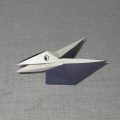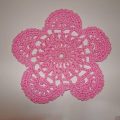We put a simple flower out of paper. A master class for beginners with a detailed outline.
In origami there are very complex products - a hundred andmore assembly steps. But there are also simple products that delight no less, especially if these simple products are flowers. Although this model will be able to collect and children, adults can also apply it (if desired) (see photo at the end of the master class).  This origami model is really simple - less10 steps assembly and the flower is ready. But do not hurry. First, select the paper for assembly or make it yourself. As for the selection of paper, two-color paper is best for this model. And how to make two-tone paper? You can take paper with one color (pink in the example) and paste a thin paper (for example, a crepe) in a different color (in the example shown, it is red). Thus, it turned out two-color paper for the bud.
This origami model is really simple - less10 steps assembly and the flower is ready. But do not hurry. First, select the paper for assembly or make it yourself. As for the selection of paper, two-color paper is best for this model. And how to make two-tone paper? You can take paper with one color (pink in the example) and paste a thin paper (for example, a crepe) in a different color (in the example shown, it is red). Thus, it turned out two-color paper for the bud.  Assemble the flower bud Step 1. First fold the sheet in half horizontally, vertically and diagonally. Before proceeding to the next step, you need to decide which color bud will be external, and which inner one.
Assemble the flower bud Step 1. First fold the sheet in half horizontally, vertically and diagonally. Before proceeding to the next step, you need to decide which color bud will be external, and which inner one.  Step 2. From the lines obtained, fold the double triangle. In the photo, the external color is pink, and the inner color is red.
Step 2. From the lines obtained, fold the double triangle. In the photo, the external color is pink, and the inner color is red.  Step 3. Fold in half, moving all the ends of the triangle in one direction:
Step 3. Fold in half, moving all the ends of the triangle in one direction:  Step 4. Take the initiative here. From corner A, make an arbitrary fold so that a triangle (ABC) with an acute angle is obtained.
Step 4. Take the initiative here. From corner A, make an arbitrary fold so that a triangle (ABC) with an acute angle is obtained.  Arrange the workpiece as shown in the photo:
Arrange the workpiece as shown in the photo:  Step 5. Number the future petals 1-2-3-4 and flip the petals 1 and 2. The order of the petals should be 3-4-1-2:
Step 5. Number the future petals 1-2-3-4 and flip the petals 1 and 2. The order of the petals should be 3-4-1-2:  Step 6. Place the adjacent petals at right angles to each other. The workpiece has become three-dimensional.
Step 6. Place the adjacent petals at right angles to each other. The workpiece has become three-dimensional.  Step 7. While holding the bud at the bottom (the protruding part obtained in step 4), open the petals, giving them the desired shape. Bud is ready!
Step 7. While holding the bud at the bottom (the protruding part obtained in step 4), open the petals, giving them the desired shape. Bud is ready! 
 Collect the bud leaf and stem. We will supply the flower with a leaf and a stem. And the leaf and stem will be obtained simultaneously. But first, we'll select (or produce) paper. The size of the square for the leaf and stem is equal to the square for the bud.
Collect the bud leaf and stem. We will supply the flower with a leaf and a stem. And the leaf and stem will be obtained simultaneously. But first, we'll select (or produce) paper. The size of the square for the leaf and stem is equal to the square for the bud.  We outline one diagonal:
We outline one diagonal:  The edges of the square are added to the diagonal:
The edges of the square are added to the diagonal:  Opposite edges add to the diagonal (at this stage, folding resembles the assembly of a sheet for a tulip).
Opposite edges add to the diagonal (at this stage, folding resembles the assembly of a sheet for a tulip).  Fold the sheet in half (diagonally):
Fold the sheet in half (diagonally):  Bend the top layer to the line AB. Turn over and repeat the action.
Bend the top layer to the line AB. Turn over and repeat the action.  Arrange the sheet as shown in the photo and bend the top left (or right), while opening the bottom. The model has acquired a three-dimensional form.
Arrange the sheet as shown in the photo and bend the top left (or right), while opening the bottom. The model has acquired a three-dimensional form.  The photo shows the finished product with a leaf turning to the left:
The photo shows the finished product with a leaf turning to the left:  Final assembly. So, we have a bud and a leaf with a stem:
Final assembly. So, we have a bud and a leaf with a stem:  These two parts are easily connected together. The bottom corner of the bud is inserted into the pocket of the leaf with the stem. The flower will not fall apart if you use a drop of glue.
These two parts are easily connected together. The bottom corner of the bud is inserted into the pocket of the leaf with the stem. The flower will not fall apart if you use a drop of glue.  The final form of the flower depends on the direction in which the leaf was rotated relative to the stem.
The final form of the flower depends on the direction in which the leaf was rotated relative to the stem.  This photo shows one of the options for using this simple but at the same time original flower.
This photo shows one of the options for using this simple but at the same time original flower.  P.S. After experimenting with the initial paper size and seeing the results, you will most likely come to the conclusion that the optimal size of the initial square for the bud and leaf with the stem is 7 cm.
P.S. After experimenting with the initial paper size and seeing the results, you will most likely come to the conclusion that the optimal size of the initial square for the bud and leaf with the stem is 7 cm.




